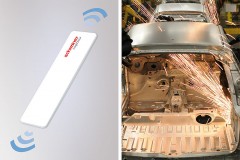RFID Labels for Specialty Applications such as Metal, ESD or Heat
The concept of the smart factory is on everyone’s lips. Companies that turn this forward-thinking scenario into reality achieve the leap into modular manufacturing and secure crucial competitive advantages—because the requirements in production and logistics are becoming increasingly complex. RFID technology assists in this endeavor by providing every component with its own identity and thereby enables autonomous control within the production process and end-to-end data acquisition across the entire supply chain. At RFID & Wireless IoT tomorrow 2019 in Darmstadt on October 29 and 30, Schreiner ProTech together with Schreiner LogiData will unveil its new ((rfid))-DistaFerr Global Label that has been optimized for worldwide use and specifically for application to metal containers. Other highlights to be showcased include ((rfid)) products for marking ESD material substrates and for high-temperature applications.
As an element of Industry 4.0 the smart factory relies on strictly data-driven processes, fully connected production with machine-material communication based on the key-lock principle and fully automated manufacturing. What sounds like a vision is already possible today: with components, machines and containers individually provided with RFID labels.
RFID on Metal
Conventional UHF RFID labels cannot be read on metal, whereas specialty labels optimized for use on metal are designed for operation in one of the two commonly used frequencies around the world: either ETSI in Europe or FCC in the NAFTA area and Asia. This means that the label can only be read in either of these two frequency bands and that objects being moved between continents are no longer readable in the respective other band.
Schreiner ProTech has therefore developed two new products for optimum data acquisition on metal across all international borders: the ((rfid))-DistaFerr Global and the ((rfid))-DistaFerr Global LongRange. Both labels take the physical properties of metal into account. The integrated dual-band antenna enables readability in both frequency bands. As a result, they can be utilized in the commonly used frequencies worldwide and reliably function on metallic substrates. The two products are identical in terms of size and design. The only difference between them is the chip they use and the related read range that varies from three to six meters, depending on the version and frequency band in which the label is read. In addition, the labels are extremely durable and, due to their minimal size and thickness, allow for flexible uses.
RFID on ESD Materials
For container marking on ESD materials, Schreiner LogiData will showcase its ESD RFID label family with the ((rfid))-DistaFerr ESD that is also available as a LongRange version. This label is designed specifically for all commonly used ESD container versions and antistatic levels and delivers read range of about seven meters.
Reliable RFID Label for High-Temperature Processes
In industrial painting or drying processes and other thermal applications, RFID labels have to withstand high temperatures while ensuring effective readability across several meters without optical line of sight. The ((rfid))-DistaFerr HighTemp 2 label resists temperatures of up to 230 °C and can be applied directly to metal, which makes it particularly suitable for painting and other high-temperature processes.
Holistic Project Consulting
As a forward-thinking development partner and holistic systems supplier of marking solutions Schreiner ProTech assists customers in all project stages relating to RFID—from in-depth consulting support concerning technology and process integration to product development through to implementation of application systems for volume production. The resulting customized solutions achieved in collaboration with Schreiner LogiData, the expert in digital label solutions, all pursue a single aim: to optimize processes and reduce costs.






